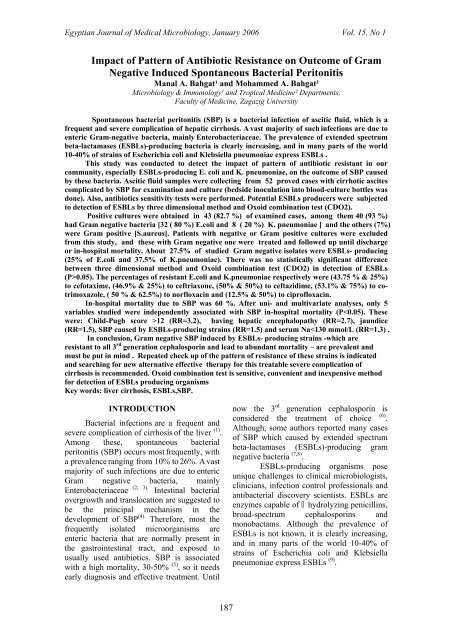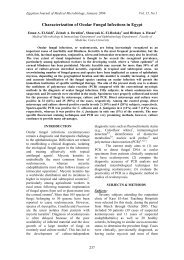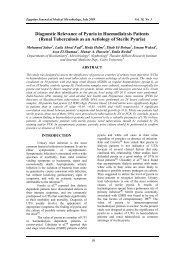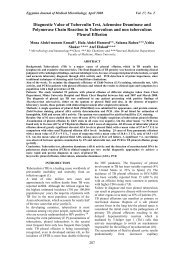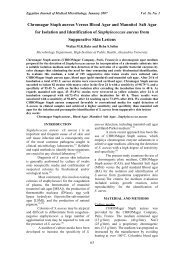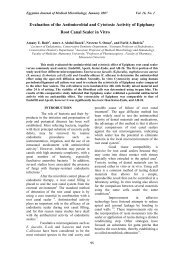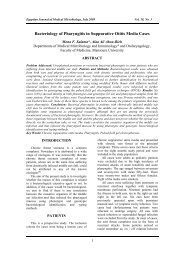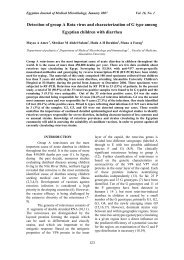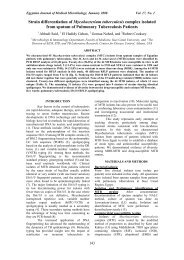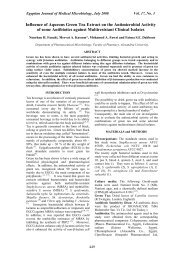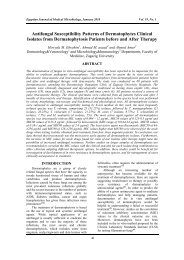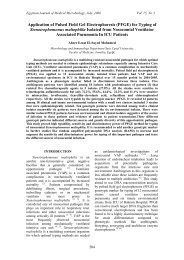Impact of Pattern of Antibiotic Resistance on Outcome of Gram ...
Impact of Pattern of Antibiotic Resistance on Outcome of Gram ...
Impact of Pattern of Antibiotic Resistance on Outcome of Gram ...
You also want an ePaper? Increase the reach of your titles
YUMPU automatically turns print PDFs into web optimized ePapers that Google loves.
Egyptian Journal <str<strong>on</strong>g>of</str<strong>on</strong>g> Medical Microbiology, January 2006 Vol. 15, No 1<br />
<str<strong>on</strong>g>Impact</str<strong>on</strong>g> <str<strong>on</strong>g>of</str<strong>on</strong>g> <str<strong>on</strong>g>Pattern</str<strong>on</strong>g> <str<strong>on</strong>g>of</str<strong>on</strong>g> <str<strong>on</strong>g>Antibiotic</str<strong>on</strong>g> <str<strong>on</strong>g>Resistance</str<strong>on</strong>g> <strong>on</strong> <strong>Outcome</strong> <str<strong>on</strong>g>of</str<strong>on</strong>g> <strong>Gram</strong><br />
Negative Induced Sp<strong>on</strong>taneous Bacterial Perit<strong>on</strong>itis<br />
Manal A. Bahgat¹ and Mohammed A. Bahgat²<br />
Microbiology & Immunology¹ and Tropical Medicine² Departments,<br />
Faculty <str<strong>on</strong>g>of</str<strong>on</strong>g> Medicine, Zagazig University<br />
Sp<strong>on</strong>taneous bacterial perit<strong>on</strong>itis (SBP) is a bacterial infecti<strong>on</strong> <str<strong>on</strong>g>of</str<strong>on</strong>g> ascitic fluid, which is a<br />
frequent and severe complicati<strong>on</strong> <str<strong>on</strong>g>of</str<strong>on</strong>g> hepatic cirrhosis. A vast majority <str<strong>on</strong>g>of</str<strong>on</strong>g> such infecti<strong>on</strong>s are due to<br />
enteric <strong>Gram</strong>-negative bacteria, mainly Enterobacteriaceae. The prevalence <str<strong>on</strong>g>of</str<strong>on</strong>g> extended spectrum<br />
beta-lactamases (ESBLs)-producing bacteria is clearly increasing, and in many parts <str<strong>on</strong>g>of</str<strong>on</strong>g> the world<br />
10-40% <str<strong>on</strong>g>of</str<strong>on</strong>g> strains <str<strong>on</strong>g>of</str<strong>on</strong>g> Escherichia coli and Klebsiella pneum<strong>on</strong>iae express ESBLs .<br />
This study was c<strong>on</strong>ducted to detect the impact <str<strong>on</strong>g>of</str<strong>on</strong>g> pattern <str<strong>on</strong>g>of</str<strong>on</strong>g> antibiotic resistant in our<br />
community, especially ESBLs-producing E. coli and K. pneum<strong>on</strong>iae, <strong>on</strong> the outcome <str<strong>on</strong>g>of</str<strong>on</strong>g> SBP caused<br />
by these bacteria. Ascitic fluid samples were collecting from 52 proved cases with cirrhotic ascites<br />
complicated by SBP for examinati<strong>on</strong> and culture (bedside inoculati<strong>on</strong> into blood-culture bottles was<br />
d<strong>on</strong>e). Also, antibiotics sensitivity tests were performed. Potential ESBLs producers were subjected<br />
to detecti<strong>on</strong> <str<strong>on</strong>g>of</str<strong>on</strong>g> ESBLs by three dimensi<strong>on</strong>al method and Oxoid combinati<strong>on</strong> test (CDO2).<br />
Positive cultures were obtained in 43 (82.7 %) <str<strong>on</strong>g>of</str<strong>on</strong>g> examined cases, am<strong>on</strong>g them 40 (93 %)<br />
had <strong>Gram</strong> negative bacteria [32 ( 80 %) E.coli and 8 ( 20 %) K. pneum<strong>on</strong>iae ] and the others (7%)<br />
were <strong>Gram</strong> positive [S.aureus]. Patients with negative or <strong>Gram</strong> positive cultures were excluded<br />
from this study, and these with <strong>Gram</strong> negative <strong>on</strong>e were treated and followed up until discharge<br />
or in-hospital mortality. About 27.5% <str<strong>on</strong>g>of</str<strong>on</strong>g> studied <strong>Gram</strong> negative isolates were ESBLs- producing<br />
(25% <str<strong>on</strong>g>of</str<strong>on</strong>g> E.coli and 37.5% <str<strong>on</strong>g>of</str<strong>on</strong>g> K.pneum<strong>on</strong>iae). There was no statistically significant difference<br />
between three dimensi<strong>on</strong>al method and Oxoid combinati<strong>on</strong> test (CDO2) in detecti<strong>on</strong> <str<strong>on</strong>g>of</str<strong>on</strong>g> ESBLs<br />
(P>0.05). The percentages <str<strong>on</strong>g>of</str<strong>on</strong>g> resistant E.coli and K.pneum<strong>on</strong>iae respectively were (43.75 % & 25%)<br />
to cefotaxime, (46.9% & 25%) to ceftriax<strong>on</strong>e, (50% & 50%) to ceftazidime, (53.1% & 75%) to cotrimoxazole,<br />
( 50 % & 62.5%) to norfloxacin and (12.5% & 50%) to cipr<str<strong>on</strong>g>of</str<strong>on</strong>g>loxacin.<br />
In-hospital mortality due to SBP was 60 %. After uni- and multivariate analyses, <strong>on</strong>ly 5<br />
variables studied were independently associated with SBP in-hospital mortality (P12 (RR=3.2), having hepatic encephalopathy (RR=2.7), jaundice<br />
(RR=1.5), SBP caused by ESBLs-producing strains (RR=1.5) and serum Na
Egyptian Journal <str<strong>on</strong>g>of</str<strong>on</strong>g> Medical Microbiology, January 2006 Vol. 15, No 1<br />
This study was c<strong>on</strong>ducted to detect<br />
the impact <str<strong>on</strong>g>of</str<strong>on</strong>g> patterns <str<strong>on</strong>g>of</str<strong>on</strong>g> antibiotic resistant in<br />
our community, especially ESBLs-producing<br />
E. coli and K. pneum<strong>on</strong>iae, <strong>on</strong> the outcome <str<strong>on</strong>g>of</str<strong>on</strong>g><br />
SBP caused by these bacteria. Also, we were<br />
compared between the three dimensi<strong>on</strong>al<br />
method and Oxoid combinati<strong>on</strong> test (CDO2)<br />
in detecti<strong>on</strong> <str<strong>on</strong>g>of</str<strong>on</strong>g> ESBLs-producing organisms.<br />
SUBJECTS, MATERIALS AND<br />
METHODS<br />
This study was d<strong>on</strong>e in Tropical<br />
Medicine and Microbiology & Immunology<br />
departments, Faculty <str<strong>on</strong>g>of</str<strong>on</strong>g> medicine Zagazig<br />
University in the period from October 2004 to<br />
May 2005. This study included 52 patients<br />
with cirrhotic ascites and primary SBP, 40<br />
males and 12 females, with mean age<br />
50±9.5years, The diagnosis <str<strong>on</strong>g>of</str<strong>on</strong>g> cirrhotic<br />
ascites was based <strong>on</strong> the clinical, laboratory<br />
(serum/ascites albumin gradient ≥1.1g/dl (10) ,<br />
and ultras<strong>on</strong>ographic examinati<strong>on</strong>. The<br />
diagnosis <str<strong>on</strong>g>of</str<strong>on</strong>g> SBP was based <strong>on</strong> presence <str<strong>on</strong>g>of</str<strong>on</strong>g><br />
ascitic PMNL count ≥250 cells/mm3<br />
(6) .<br />
Patients with sec<strong>on</strong>dary perit<strong>on</strong>itis or had<br />
previous attacks <str<strong>on</strong>g>of</str<strong>on</strong>g> SBP were excluded from<br />
this study. Cases with negative or <strong>Gram</strong><br />
positive cultures were excluded from the<br />
study <str<strong>on</strong>g>of</str<strong>on</strong>g> in-hospital mortality (i.e. death<br />
during hospitalizati<strong>on</strong> for an SBP episode)<br />
predictive factors. All patients were submitted<br />
for the followings:<br />
1- History taking and clinical examinati<strong>on</strong><br />
with emphasis <strong>on</strong> symptoms and signs<br />
attributed to SBP and liver cell failure.<br />
2-Ascitic fluid examinati<strong>on</strong> and culture:<br />
A-Paracentesis was performed for all<br />
patients at admissi<strong>on</strong> and ascitic fluid<br />
samples were examined microscopic-ally<br />
(for white cell count) and chemically (for<br />
assay <str<strong>on</strong>g>of</str<strong>on</strong>g> total protein, albumin, LDH and<br />
glucose levels) to c<strong>on</strong>firm the diagnosis<br />
<str<strong>on</strong>g>of</str<strong>on</strong>g> SBP.<br />
B-Also, another 10ml <str<strong>on</strong>g>of</str<strong>on</strong>g> ascitic fluid<br />
samples were inoculated into blood<br />
culture bottles (oxoid) at the patient’s<br />
bedside, incubated at 37°C for 7 days, and<br />
examined daily for turbidity. These<br />
cultures were subcultured after 2 and 7<br />
days <strong>on</strong> chocolate-enriched agar plates for<br />
aerobic and anaerobic growth. The plates<br />
were incubated for 1 or 2 days at 37°C,<br />
and organisms were identified (11).<br />
C-Col<strong>on</strong>ies were subjected to identificati<strong>on</strong><br />
by standard bacteriological methods,<br />
according to Baiely and Scott (12) and by<br />
API E (bio-Mérieux) for GNB species<br />
identificati<strong>on</strong>.<br />
D –<strong>Gram</strong> negative bacteria (GNB) were<br />
tested for antibiotic sensitivity by disc<br />
diffusi<strong>on</strong> method according to Bauer et al.<br />
(13)<br />
using the following antibiotic discs<br />
(Oxoid): ceftriax<strong>on</strong>e (30 µg), cefotaxime<br />
(30µg), ceftazidime (30 µg), cipr<str<strong>on</strong>g>of</str<strong>on</strong>g>loxacin<br />
(5µg), norfloxacin (5µg) and Cotrimoxazole<br />
( 25 µg).<br />
E- Each Klebsiella pneum<strong>on</strong>iae or<br />
Escherichia coli isolate should be<br />
c<strong>on</strong>sidered a potential ESBLs-producer if<br />
the test results are as follows: ceftriax<strong>on</strong>e<br />
< 25 mm , cefotaxime < 27 mm,<br />
and/or ceftazidime < 22 mm. (13).<br />
3-Potential ESBLs producers GNB were<br />
subjected to detecti<strong>on</strong> <str<strong>on</strong>g>of</str<strong>on</strong>g> ESBLs by three<br />
dimensi<strong>on</strong>al method and Oxoid<br />
combinati<strong>on</strong> test (CDO2) that depends <strong>on</strong><br />
comparing the inhibiti<strong>on</strong> z<strong>on</strong>e give by<br />
ceftazidime (CAZ 30 µg) and ceftazidimeplus-clavulanate<br />
(30 µg/ 10 µg) according<br />
to NCCLs methodology. A difference <str<strong>on</strong>g>of</str<strong>on</strong>g><br />
≥5mm between the z<strong>on</strong>e <str<strong>on</strong>g>of</str<strong>on</strong>g> CDO2 and CAZ<br />
al<strong>on</strong>e was taken to indicate ESBLs<br />
producti<strong>on</strong>, advocated by the manufacturer<br />
(15) .<br />
4-Blood Samples which were obtained at<br />
admissi<strong>on</strong> from all patients were examined<br />
for the followings: complete blood cell<br />
count, liver functi<strong>on</strong> tests, urea and<br />
creatinine, and serum Na .<br />
5- The severity <str<strong>on</strong>g>of</str<strong>on</strong>g> liver disease was assessed<br />
by the Child-Pugh scoring system, in which<br />
5–15 points are assigned and a higher score<br />
indicates greater severity <str<strong>on</strong>g>of</str<strong>on</strong>g> liver failure.<br />
Patients in Child-Pugh class A have<br />
preserved liver functi<strong>on</strong> (5–6 points),<br />
patients in class B have moderate liver<br />
failure (7–9 points), and patients in class C<br />
have severe liver failure (10–15 points) (11) .<br />
6-Abdominal ultras<strong>on</strong>ographic examinati<strong>on</strong><br />
was carried out using real- time equipment<br />
(ALOKA SSD-500) with c<strong>on</strong>vex linear<br />
transducer <str<strong>on</strong>g>of</str<strong>on</strong>g> 3.5 MHz frequency.<br />
7-All cases <str<strong>on</strong>g>of</str<strong>on</strong>g> SBP were treated empirically<br />
with I.V cefotaxime ( Claforan, Aventis) 2<br />
gm every 8 hrs for 7 days (6) beside other<br />
needed therapy. The antibiotic was changed<br />
in some cases who still alive according to<br />
results <str<strong>on</strong>g>of</str<strong>on</strong>g> drug sensitivity tests. These cases<br />
188
Egyptian Journal <str<strong>on</strong>g>of</str<strong>on</strong>g> Medical Microbiology, January 2006 Vol. 15, No 1<br />
were followed up until discharge or inhospital<br />
death.<br />
8-All data were collected, tabulated and<br />
statistically analyzed using the computer<br />
program SPSS versi<strong>on</strong>10.<br />
RESULTS<br />
Causative organisms were isolated<br />
from ascitic fluid were mainly <strong>Gram</strong>-negative<br />
bacilli (GNB) (93%), E.coli was the most<br />
frequently isolated organism (80%) followed<br />
by K.pneum<strong>on</strong>iae (20%) (Table 1).<br />
The <str<strong>on</strong>g>Antibiotic</str<strong>on</strong>g> resistance <str<strong>on</strong>g>of</str<strong>on</strong>g> the isolated GNB<br />
is shown in Table 3. The percentages <str<strong>on</strong>g>of</str<strong>on</strong>g><br />
resistant E.coli and K.pneum<strong>on</strong>iae<br />
respectively were (43.75 % & 25%) to<br />
cefotaxime, (46.9% & 25%) to ceftriax<strong>on</strong>e,<br />
(50% & 50%) to ceftazidime, (53.1% & 75%)<br />
to co-trimoxazole, ( 50 % & 62.5%) to<br />
norfloxacin and (12.5% & 50%) to<br />
cipr<str<strong>on</strong>g>of</str<strong>on</strong>g>loxacin. All ESBLs- producing strains<br />
were also resistant to norfloxacin and cotrimoxazole<br />
and 63.7 % <str<strong>on</strong>g>of</str<strong>on</strong>g> them were<br />
resistant to cipr<str<strong>on</strong>g>of</str<strong>on</strong>g>loxacin.<br />
About 27.5% <str<strong>on</strong>g>of</str<strong>on</strong>g> studied <strong>Gram</strong><br />
negative isolates were ESBLs- producing<br />
(25% <str<strong>on</strong>g>of</str<strong>on</strong>g> E.coli and 37.5% <str<strong>on</strong>g>of</str<strong>on</strong>g> K.pneum<strong>on</strong>iae)<br />
Table 4.<br />
When the results <str<strong>on</strong>g>of</str<strong>on</strong>g> three dimensi<strong>on</strong>al<br />
method were compared to results <str<strong>on</strong>g>of</str<strong>on</strong>g> Oxoid<br />
combinati<strong>on</strong> test (CDO2). There was no<br />
statistically significant difference between the<br />
two methods in detecti<strong>on</strong> <str<strong>on</strong>g>of</str<strong>on</strong>g> ESBLs (P>0.05)<br />
Table 5.<br />
In-hospital mortality due to <strong>Gram</strong><br />
negative induced SBP was 60 % <str<strong>on</strong>g>of</str<strong>on</strong>g> studied<br />
cases. Two infected cases with resistant <strong>Gram</strong><br />
negative bacteria to cefotaxime (<strong>on</strong>e <str<strong>on</strong>g>of</str<strong>on</strong>g> them<br />
ESBLs producer) were being alive when<br />
results <str<strong>on</strong>g>of</str<strong>on</strong>g> ascitic fluid culture appeared,<br />
cefotaxime was replaced by cipr<str<strong>on</strong>g>of</str<strong>on</strong>g>loxacin 400<br />
mg I.V. every 12 hrs for <strong>on</strong>e week, and both<br />
<str<strong>on</strong>g>of</str<strong>on</strong>g> them survived (Table 6).<br />
Table 1: Results <str<strong>on</strong>g>of</str<strong>on</strong>g> ascitic fluid culture <str<strong>on</strong>g>of</str<strong>on</strong>g> patients with SBP (n=52).<br />
1- Negative culture 9/52 17.3%<br />
2- Positive culture: 43/52 82.7%<br />
a. <strong>Gram</strong> +ve (S.aureus) 3/43 7%<br />
B-<strong>Gram</strong> –ve: 40/43 93%<br />
• E.coli<br />
• K.pneum<strong>on</strong>iae<br />
32/40 80%<br />
8/40 20%<br />
189
Egyptian Journal <str<strong>on</strong>g>of</str<strong>on</strong>g> Medical Microbiology, January 2006 Vol. 15, No 1<br />
Table 2: Characteristics <str<strong>on</strong>g>of</str<strong>on</strong>g> studied SBP patients* (n=40).<br />
• Age (years)<br />
• Gender (M/F)<br />
• Clinical presentati<strong>on</strong> :<br />
- Fever<br />
- Abd. Pain<br />
- Abd. Tenderness<br />
- Hepatic encephalopathy<br />
- Jaundice<br />
- Splenomegaly<br />
- Hematemesis<br />
- Hepatorenal syndrome<br />
• Investigati<strong>on</strong>s:<br />
- Leucocytosis<br />
- Leucopenia<br />
- Thrombocytopenia<br />
- Anaemia (HB1.3 mg/dl)<br />
- Serum Na (
Egyptian Journal <str<strong>on</strong>g>of</str<strong>on</strong>g> Medical Microbiology, January 2006 Vol. 15, No 1<br />
Table 4: The distributi<strong>on</strong> <str<strong>on</strong>g>of</str<strong>on</strong>g> microorganisms producing ESBLs am<strong>on</strong>g E.coli &<br />
K.pneum<strong>on</strong>iae species.<br />
Microorganism № %<br />
E.coli 8 /32 25 %<br />
K.pneum<strong>on</strong>iae 3 /8 37.5 %<br />
Total 11 /40 27.5%<br />
Table 5: Comparis<strong>on</strong> <str<strong>on</strong>g>of</str<strong>on</strong>g> ESBLs results by Oxoid combinati<strong>on</strong> test and three dimensi<strong>on</strong>al<br />
method.<br />
Oxoid<br />
combinati<strong>on</strong> test<br />
three<br />
dimensi<strong>on</strong>al<br />
Fisher<br />
extract test P value<br />
n=20 method n=20 χ²<br />
10 (50%) 11 (55%) 0.1 > 0.05<br />
Table 6: Predictive factors for in-hospital mortality in patients with <strong>Gram</strong> negative SBP.<br />
Variable<br />
Univariate analysis<br />
Multivariate analysis<br />
P* RR 95%CI P** RR 95%CI<br />
Age > 50 years 0.05 - -<br />
Child-pugh score>12
Egyptian Journal <str<strong>on</strong>g>of</str<strong>on</strong>g> Medical Microbiology, January 2006 Vol. 15, No 1<br />
other tested antibiotics. Moreover, the<br />
proporti<strong>on</strong>s <str<strong>on</strong>g>of</str<strong>on</strong>g> cefotaxime resistant strains<br />
am<strong>on</strong>g isolated <strong>Gram</strong> negative bacilli were<br />
(43.75%) for E. coli and (25%) for K.<br />
pneum<strong>on</strong>iae and most <str<strong>on</strong>g>of</str<strong>on</strong>g> them had crossresistance<br />
to other studied antibiotics<br />
(Table3).These high proporti<strong>on</strong>s which reflect<br />
the improper use <str<strong>on</strong>g>of</str<strong>on</strong>g> antibiotics in our<br />
community, make the empirical use <str<strong>on</strong>g>of</str<strong>on</strong>g><br />
cefotaxime or other 3 rd generati<strong>on</strong><br />
cephalosporin for treatment <str<strong>on</strong>g>of</str<strong>on</strong>g> SBP<br />
questi<strong>on</strong>able. Also increasing the resistant E.<br />
coli and K. pneum<strong>on</strong>iae strains to norfloxacin<br />
(50% and 62.5% respectively) and cotrimoxazole<br />
(53.1% & 75% respectively)<br />
reduce the effectiveness <str<strong>on</strong>g>of</str<strong>on</strong>g> these antibiotics in<br />
preventi<strong>on</strong> <str<strong>on</strong>g>of</str<strong>on</strong>g> SBP attacks.<br />
On the other hand, it is a worldwide<br />
tendency that ESBLs-producing strains are<br />
increasing in proporti<strong>on</strong><br />
(7,17) ,and their<br />
presence in our community was reported<br />
(18) ,so it is important to pay attenti<strong>on</strong> to this<br />
growing problem and to investigate deeply<br />
their extensi<strong>on</strong> and its resistance pattern.<br />
There was no statistically significant<br />
difference between three dimensi<strong>on</strong>al method<br />
and Oxoid combinati<strong>on</strong> test (CDO2) in<br />
detecti<strong>on</strong> <str<strong>on</strong>g>of</str<strong>on</strong>g> ESBLs (P>0.05). Oxoid<br />
combinati<strong>on</strong> test (CDO2) was proved by Ho,<br />
et al and Fam and El-Damarawy to be a<br />
sensitive, c<strong>on</strong>venient and inexpensive method<br />
which can be incorporated into routine<br />
clinical laboratory service (19,20) .<br />
The in-hospital mortality <str<strong>on</strong>g>of</str<strong>on</strong>g> our SBP<br />
cases was 60% which is similar to that reported<br />
by Henz et al (1995) (21) and more than the<br />
results <str<strong>on</strong>g>of</str<strong>on</strong>g> other authors (30-50%) (22) .This high<br />
mortality reflects the severity <str<strong>on</strong>g>of</str<strong>on</strong>g> our cases (65<br />
% had Child-Plugh score >12). The multivariate<br />
analysis dem<strong>on</strong>strated that from a total <str<strong>on</strong>g>of</str<strong>on</strong>g> 24<br />
variables analyzed ( most <str<strong>on</strong>g>of</str<strong>on</strong>g> them in table 2),<br />
<strong>on</strong>ly Child-Pugh score >12 , having hepatic<br />
encephalopathy, jaundice, SBP caused by<br />
ESBL-producing strains and serum Na
Egyptian Journal <str<strong>on</strong>g>of</str<strong>on</strong>g> Medical Microbiology, January 2006 Vol. 15, No 1<br />
management. Gastroenterologist; 3:311-<br />
28.<br />
7- Park,YH; Lee, HC; S<strong>on</strong>g,HG et al (2003):<br />
Recent increase in antibiotic-resistant<br />
microorganisms in patients with<br />
sp<strong>on</strong>taneous bacterial perit<strong>on</strong>itis<br />
adversely affects the clinical outcome in<br />
Korean.J. Gastroenterol. & Hepatol.;<br />
18:927-33.<br />
8- Kang,CI; Kim, SH; Park, WB et al (2004):<br />
Clinical outcome <str<strong>on</strong>g>of</str<strong>on</strong>g> bacteremic<br />
sp<strong>on</strong>taneous bacterial perit<strong>on</strong>itis due to<br />
extended spectrum beta-lactamaseproducing<br />
Escherichia coli and Klebsiella<br />
pneum<strong>on</strong>iae. Korean. J. Intern. Med. ;<br />
19:160-4.<br />
9- Rupp ME, Fey PD.(2003): Extended<br />
spectrum beta-lactamase (ESBL)-<br />
producing Enterobacteriaceae: c<strong>on</strong>siderati<strong>on</strong>s<br />
for diagnosis, preventi<strong>on</strong> and drug<br />
treatment. Drugs.;63(4):353-65.<br />
10- Campillo B, Richardet J, Kheo T, and<br />
Dupeyr<strong>on</strong> C. (2002): Nosocomial<br />
Sp<strong>on</strong>taneous Bacterial Perit<strong>on</strong>itis and<br />
Bacteremia in Cirrhotic Patients: <str<strong>on</strong>g>Impact</str<strong>on</strong>g><br />
<str<strong>on</strong>g>of</str<strong>on</strong>g> Isolate Type <strong>on</strong> Prognosis and<br />
Characteristics <str<strong>on</strong>g>of</str<strong>on</strong>g> Infecti<strong>on</strong>. Clin. Infect.<br />
Dis.; 35:1–10.<br />
11- Bailey, V R. and Scott, E G.(1990):<br />
Diagnostic Microbiology. 8 th ed. The C V.<br />
Mosby Co2, Saint Louis Tor<strong>on</strong>to, L<strong>on</strong>d<strong>on</strong>.<br />
12- Bauer, A W; Kirby, W M; Sherris; J C.<br />
and Turck, M. (1966): <str<strong>on</strong>g>Antibiotic</str<strong>on</strong>g><br />
susceptibility testing by the standerd<br />
single disk method. A. J. Clin.<br />
Pathol.;45:493-496.<br />
13- Nati<strong>on</strong>al Committee for Clinical<br />
Laboratory Standards. (1999).<br />
Performance standards for antimicrobial<br />
susceptibility testing. NCCLS approved<br />
standard M100-S9. Nati<strong>on</strong>al Committee<br />
for Clinical Laboratory Standards, Wayne,<br />
PA.<br />
14- Carter MW, Oakt<strong>on</strong> KS, Marner M, et<br />
al.(2000): Detecti<strong>on</strong> <str<strong>on</strong>g>of</str<strong>on</strong>g> extended spectrum<br />
β-lactmases in Klebsiellae with oxoid<br />
combinati<strong>on</strong> disk method. J. clin.<br />
Microbiol; 38(11):4228.<br />
15- Akriviadis, EA; Kapnias, D; Hadjigavriel,<br />
M. et al (1996):Serum/ascites albumin<br />
gradient: its value as a rati<strong>on</strong>ala\ approach<br />
to the differential diagnosis <str<strong>on</strong>g>of</str<strong>on</strong>g> ascites.<br />
Scand.J.Gastroenterol.;31:814-7.<br />
16- Jain.AP; Chandra,LS; Gupta. S et al<br />
(1999):Sp<strong>on</strong>taneous bacterial perit<strong>on</strong>itis<br />
in liver cirrhosis with ascites. J. Asso.<br />
Physicians India; 47:619-21.<br />
17- Kader,AA and Kumar,Ak (2004):<br />
Prevalence <str<strong>on</strong>g>of</str<strong>on</strong>g> extended spectrum betalactamase<br />
am<strong>on</strong>g multidrug resistant<br />
gram-negative isolates from a general<br />
hospital in Saudi Arabia. Saudi. Med.<br />
J.;25:570-4.<br />
18- Sadeq, RA ; El-Hosiny, M ;Mowafy, H.<br />
et al (2001): The bacterial causes <str<strong>on</strong>g>of</str<strong>on</strong>g><br />
nosocomial infecti<strong>on</strong>s associated with<br />
short and l<strong>on</strong>g term-catheter: A<br />
comparative study. Z.U.M.J.;7:2303-14.<br />
19- Ho PL, Chow KH, Yuen KY, et al.<br />
(1998).Comparis<strong>on</strong> <str<strong>on</strong>g>of</str<strong>on</strong>g> a novel, inhibitorpotentiated<br />
disc diffusi<strong>on</strong> test with other<br />
methods for detecti<strong>on</strong> <str<strong>on</strong>g>of</str<strong>on</strong>g> extended<br />
spectrum beta lactamases in Escherichia<br />
coli and Klebsiella pneum<strong>on</strong>iae. J<br />
Antimicrob. Chemother; 42 (1):49-54.<br />
20- Fam NS and El-Damarawy M (2002).<br />
Detecti<strong>on</strong> <str<strong>on</strong>g>of</str<strong>on</strong>g> extended spectrum beta<br />
lactamases producing bacteria in<br />
intensive care unit: impact <strong>on</strong> resistance<br />
to beta lactamase inhibitors and other<br />
antimicrobials. Egypt J Med. Microbiol;<br />
11(3):569-580.<br />
21- Henz, S; Buhler, H and Pirovino, M.<br />
(1995): Sp<strong>on</strong>taneous bacterial perit<strong>on</strong>itis:<br />
diagnostic and prognostic aspects.<br />
Schweiz. Med. Wochenschr;125:2379-86<br />
[English abstract].<br />
22- Gomez-Jimenez, J ;Ribera, E ;Martinez-<br />
Vazquez, JM et al (1992): Bacterial<br />
perit<strong>on</strong>itis in cirrhosis. Prospective study<br />
<str<strong>on</strong>g>of</str<strong>on</strong>g> 80 episodes. Med.Clin. (Barc); 99:493-<br />
7 [English abstract].<br />
23- Gines, P ;Berl, T ; Bernardi, M. et al<br />
(1998): Hyp<strong>on</strong>atraemia in cirrhosis: from<br />
pathogenesis to treatment. Hepatology;<br />
28:851.<br />
24-Fernandez, J; Bauer, TM; Navasa, M and<br />
Rodes, J. (2000): Diagnosis, treatment<br />
and preventi<strong>on</strong> <str<strong>on</strong>g>of</str<strong>on</strong>g> sp<strong>on</strong>taneous bacterial<br />
perit<strong>on</strong>itis. Baillieres Best Pract. Res.<br />
Clin.Gastroenterol. 14:975-990.<br />
193
Egyptian Journal <str<strong>on</strong>g>of</str<strong>on</strong>g> Medical Microbiology, January 2006 Vol. 15, No 1<br />
اثر نمط المقاومة للمضادات الحيوية على عاقبة مرضى التهاب الصفاق البكتيرى<br />
التلقائى الناتج عن بكتريا سلبية الجرام .<br />
منال بهجت ، محمد بهجت<br />
قسمى الميكروبيولوجى والامراض المتوطنة – طب الزقازيق<br />
يعتبر التهاب الصفاق البكتيري التلقائي- وهو عبارة عن عدوى بكتيرية للسائل الاستسقائى بالبطن-<br />
يعتبر من<br />
المضاعفات المتكررة والخطيرة لتشمع الكبد،وهو ناتج في معظم الحالات عن عدوى ببكتيريا معوية سلبية الجرام،<br />
خصوصا ً الأمعائيات<br />
.<br />
وقد ازداد فى الفترة الأخيرة انتشار البكتريا المفرزه لإنزيمات البيتالاكتاميز واسعة المجال ،<br />
حيث يصل مدى انتشارها في عدد من الأماكن إلى<br />
و( الكلبسيله الرئوية).<br />
٪٤٠-١٠<br />
من السلالات المعزولة ل(الايشيريشيا القولونية)<br />
وقد صممت هذه الدراسة لتحديد اثر نمط المقاومة للمضادات الحيوية خصوصا ً للبكتريا سلبية الجرام المفرزه<br />
لإنزيمات البيتالاكتاميز واسعة المجال،<br />
على عاقبة مرض التهاب الصفاق البكتيري التلقائي الناتج عن هذا النوع من<br />
البكتريا ، حيث تم جمع عينات من السائل الاستسقائى من ٥٢ مريضا بتشمع الكبد المصحوب بالتهاب الصفاق البكتيري<br />
التلقائي لفحصها وزراعتها<br />
الحساسية للمضادات الحيوية<br />
.<br />
بطريقتي الأبعاد الثلاثة واختبار اكسويد التوافقى.<br />
(باستخدام تقنيه الزرع بجانب المريض في قناني مزارع الدم)<br />
، كما تم إجراء اختبارات<br />
وبالنسبة لتحديد السلالات المفرزه لإنزيمات البيتالاكتاميز واسعة المجال فقد تم ذلك<br />
وقد تم الحصول على ٤٣ مزرعة أي جابية (٨٢,٧٪)<br />
حالة ايشيريشيا القولونيه<br />
إيجابية الجرام<br />
،<br />
٤٠ مزرعة منها نتج عنها بكتريا سلبية الجرام<br />
٣٢))<br />
و (٨٠٪)<br />
٨ حالات(٢٠ (٪<br />
كلبسيله الرئوية))<br />
،<br />
)<br />
بينما أظهرت الحالات الثلاثة الباقية بكتيريا<br />
المكوره العنقودية الذهبية). وقد تم استبعاد الحالات ذات المزارع السلبية أو التى أظهرت بكتريا إيجابية<br />
الجرام من هذه الدراسة، بينما تم علاج ومتابعة الحالات ذات المزارع سلبيه الجرام حتى الشفاء أو الوفاة بالمستشفى<br />
وقد أوضحت هذه الدراسة ان<br />
.<br />
٢٧,٥<br />
المجال (%25 من حالات الايشيريشيا القولونيه و<br />
٪ من البكتريا سلبيه الجرام المعزولة تفرز إنزيمات البيتالاكتاميز واسعة<br />
٣٧,٥<br />
إحصائية بين الطريقتين المستخدمتين فى تمييز البكتريا المفرزة لهذه الإنزيمات<br />
.<br />
٪ من حالات الكلبسيله الرئويه)، ولم يظهر أى فرق ذو دلاله<br />
إما بالنسبة إلى سلالات الايشيريشيا القولونيه والكلبسيله الرئوية المقاومة للمضادات الحيوية فقد كانت كالأتى<br />
-:<br />
٤٣,٧٥) ٪ و (٪ ٢٥<br />
لسيفوتاكسم و<br />
٪٤٦,٩) و (٪٢٥<br />
لسيفترياكسون و<br />
٪٥٠) و (٪٥٠<br />
لسيفتازيديم و<br />
(٥٣,١٪ و٧٥<br />
(٪<br />
لكوترايموكسازول و<br />
٪٥٠) و٦٢,٥ (٪<br />
لنورفلكساسين و<br />
٪١٢,٥) و (٪ ٥٠<br />
لسبيروفلكساسين على التوالي.<br />
وقد كانت نسبه الوفيات داخل المستشفى الناتجة عن التهاب الصفاق البكتيري التلقائي ٦٠٪ من الحالات المدروسة ، وبعد<br />
إجراء التحليل الاحصائى للمتغيرات المفردة والمتعددة ، تبين ان<br />
: الوفيات وهى<br />
٥ متغيرات منهم كانت مستقلة و لها دور في هذه<br />
مجموع نقاط تشيلد –بف اكثر من ١٢ أو وجود اعتلال مخي كبدى أو يرقان أو العدوى بسلالات مفرزة<br />
لانزيمات البيتالاكتاميز واسعة المجال أو انخفاض مستوى الصوديوم بالدم.<br />
ومما سبق نستنتج ان حالات التهاب الصفاق البكتيري التلقائي الناتج عن بكتيريا سلبية الجرام ومفرزة<br />
لإنزيمات البيتالاكتاميز واسعة المجال والتي تقاوم كل عقاقير الجيل الثالث للكيفالوسبورم المستخدمة لعلاج هذه المرض<br />
منتشرة في منطقتنا و تسبب العديد من الوفيات ، لذا يجب التنبه لها ووضعها في الاعتبار<br />
.<br />
كما ننصح بإجراء اختبارات<br />
متكررة لمتابعة نمط المقاومة للمضادات الحيوية لهذه السلالات والبدء في البحث عن علاج بديل فعال لعلاج هذه العدوى.<br />
كما وجد ان اختبار اكسويد التوافقي بالغ الدقة ومعقول الثمن وملائم للكشف عن السلالات المفرزة لإنزيمات<br />
البيتالاكتاميز واسعة المجال.<br />
194


